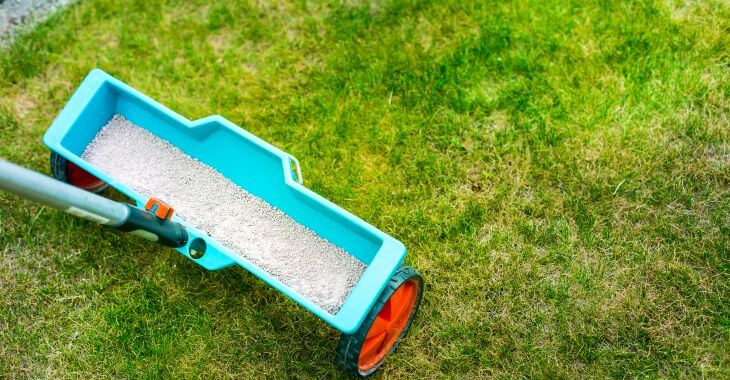The Best Fall Fertilizer for Your Lawn

Preparing your lawn for the fall season is one of the best ways to ensure lush, healthy grass in the spring. By choosing the best fall fertilizer for your lawn, you can strengthen root systems, improve nutrient absorption, and protect against cold weather.
Here’s everything you need to know about choosing the best fall lawn fertilizer, why fall treatments are important, and how to get the most out of your lawn care routine this season.
Why Use Fall Fertilizer?
Fall is a critical season for lawn care, and using the best lawn fertilizer for fall can help keep your grass healthy, even in cold weather. During autumn, lawns shift their energy from rapid growth to nutrient storage, allowing grass roots to grow stronger and absorb essential nutrients from fertilizer.
Fall lawn treatment also helps repair summer damage, like bare patches, weakened grass, and soil nutrient depletion. By replenishing nutrients with a fall lawn fertilizer, you’ll not only boost the health of your grass but also create a vibrant, greener lawn as temperatures warm up in the spring.
Key Nutrients in Fall Fertilizers
Not all fertilizers are created equal, and understanding the essential nutrients for fall can help you choose the best fall lawn fertilizer for your lawn’s needs.
1. Nitrogen (N)
Nitrogen is essential for green growth and lush appearance, making it a primary ingredient in most fertilizers. In the fall, nitrogen is important but should be applied in moderation. Too much nitrogen can encourage growth that’s too rapid, which could weaken your grass as temperatures drop.
Look for a balanced fall fertilizer with moderate nitrogen content to keep the grass green while supporting root health without overstimulation.
2. Phosphorus (P)
Phosphorus supports root growth, making it particularly important for fall lawn treatments. Since this nutrient helps with root development, it enables your grass to absorb nutrients more effectively and establish a strong foundation for spring growth, making it an ideal component in fall lawn fertilizer.
3. Potassium (K)
Potassium strengthens grass, making it resistant to diseases and more adaptable to changing temperatures. A fall fertilizer with sufficient potassium can improve your lawn’s resilience against frost and winter damage to survive winter dormancy and return stronger in spring.
Choosing the Best Fall Fertilizer for Your Lawn
Selecting the best lawn fertilizer for fall depends on your grass type, soil condition, and climate. Here are a few options to consider based on popular fall fertilization practices:
Slow-Release Fertilizers
Slow-release fertilizers release nutrients gradually, allowing for steady absorption over time. These fertilizers work well for fall, as they provide nutrients in controlled amounts to strengthen grass roots without overwhelming them, which is ideal for lawns with clay or loamy soil.
Winterizing Fertilizers
Winterizing fertilizers are formulated specifically to prepare your lawn for winter. These blends usually contain high potassium levels to promote resilience and cold resistance. Winterizing fertilizers are a solid choice if your region experiences freezing temperatures and frost.
Organic Fertilizers
Organic fertilizers offer a more natural way to nourish your lawn. They often include composted materials, manure, and plant-based nutrients. While they may work more slowly than synthetic fertilizers, organic fertilizers enrich the soil and encourage healthy microbial growth.
How to Apply Fall Fertilizer for Best Results
Applying the best fall fertilizer is only part of a successful fall lawn treatment. Timing, coverage, and follow-up care are essential to getting the most out of your lawn fertilizer.
Timing is Everything
The best time to apply fall fertilizer is between early September and late November, depending on your region. Ideally, you should apply the fertilizer when temperatures are cooler but before the first frost. Applying fertilizer too late can limit its effectiveness.
Proper Application
Using a spreader can help you apply fertilizer evenly. Avoid applying too much fertilizer in any one spot, as this can lead to burning and damage. Follow the recommended rate listed on your fertilizer bag for optimal results. Spread the fertilizer in two directions to ensure thorough coverage.
Watering After Application
Watering your lawn after applying fertilizer helps the nutrients absorb into the soil more effectively. A light watering is usually sufficient, as over-watering can wash away nutrients. Watering also helps prevent fertilizers from burning your grass.
Tips for a Successful Fall Lawn Treatment
A comprehensive fall lawn treatment can help make the most of your fertilizer application and give your lawn an even greater chance to thrive. In addition to choosing the best fall fertilizer, consider these additional tips:
- Aerate Your Lawn: Aerating loosens compacted soil, making it easier for nutrients and water to reach the roots. Fall is an ideal time for aeration, as it allows fertilizer to be absorbed deeply.
- Remove Dead Leaves: Leaves can create a barrier that prevents sunlight and water from reaching the soil. Regularly raking or mulching leaves keeps your lawn clear and ensures that fertilizer has direct contact with the soil.
- Overseed Thin Areas: If you have bare spots or thinning grass, overseeding in the fall can help. By seeding these areas after fertilizing, you create a full, dense lawn by spring.
Choosing the best fall fertilizer for your lawn can make a significant difference in how well your grass endures winter and thrives come spring. With the right balance of nutrients and proper application, fall fertilization strengthens roots, repairs summer damage, and protects against winter stress.

Whether you choose a slow-release, winterizing, or organic fertilizer, the benefits of fall lawn treatment are clear. Invest in the health of your lawn this fall to enjoy a vibrant, lush landscape next year.
